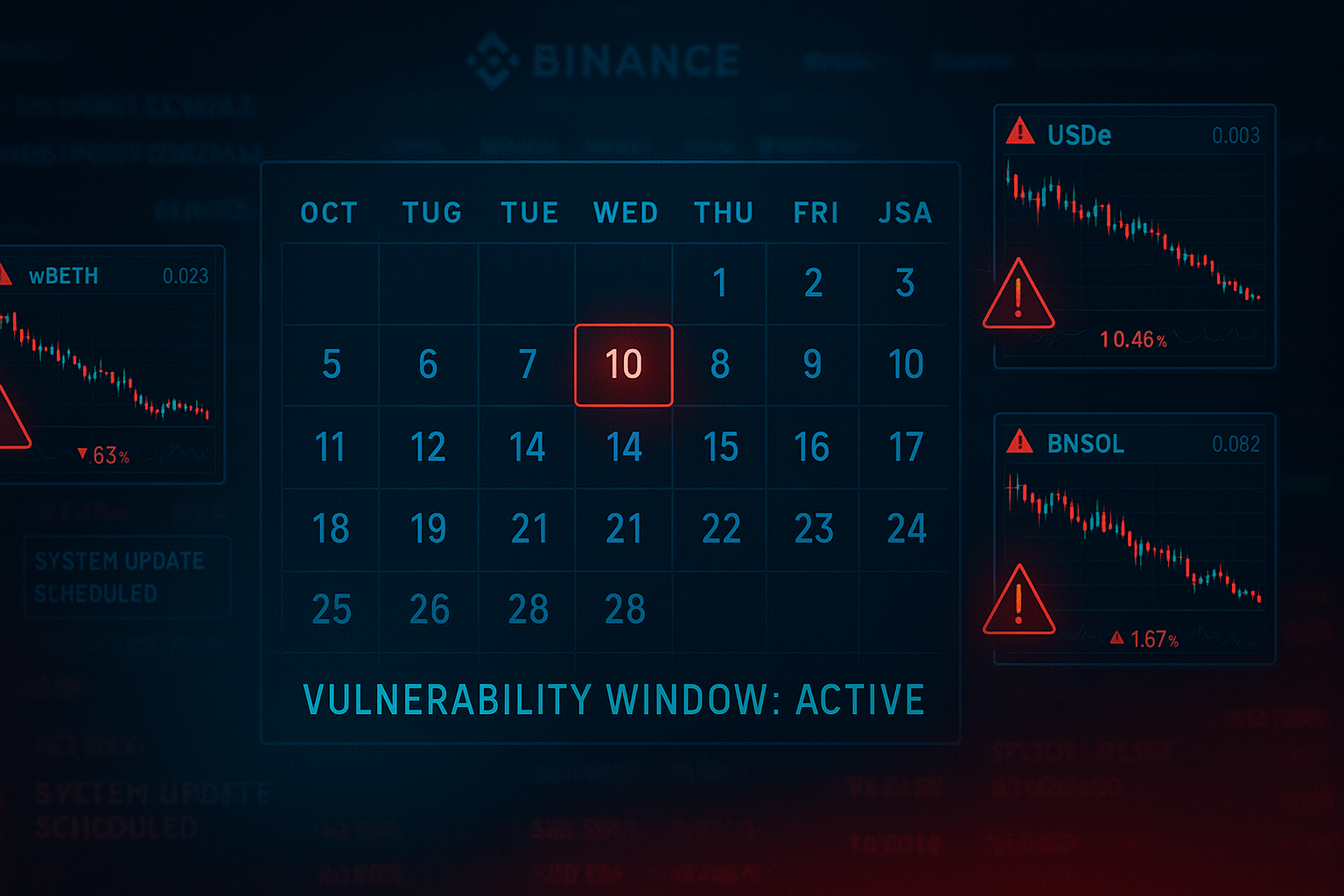A 125-year-old playbook, a modern crypto exchange, and why your whinging won’t change a bloody thing
 Ahoy there, Trader! ⚓️
Ahoy there, Trader! ⚓️
It’s Phil…
On October 10, 2025, at precisely 4:50 PM Eastern Time, the cryptocurrency market experienced what analysts are calling “the largest liquidation event in crypto history.”1 Within 24 hours, $19 billion in leveraged positions evaporated. Bitcoin plunged from $122,000 to $104,000. Ethereum cratered 21%. And 1.6 million traders—from retail punters to institutional whales—watched their accounts get obliterated.2
The trigger? A Trump tariff threat against China, announced after traditional markets had closed for the day.3
But here’s what the breathless headlines and Twitter meltdowns won’t tell you: this exact playbook is 125 years old.
In fact, if Jesse Livermore were alive today, he’d look at Binance’s October 10th performance and think: “Bloody hell, these lads are running the same bucket shop tricks I used in 1900—except with better technology and lawyers.”
And he’d be absolutely right.

The Boy Plunger Would Recognise This Game
Let me take you back to Boston, 1892. A 15-year-old kid named Jesse Livermore is working as a board boy at Paine, Webber & Co., chalking up stock prices during his lunch breaks.4 He’s got a ledger where he’s tracking price patterns, and he’s figured something out: he can predict short-term moves better than the degenerates betting at the local bucket shops.
For those unfamiliar with this bit of financial history: bucket shops were the 19th-century equivalent of today’s dodgy offshore crypto exchanges. They didn’t actually buy or sell securities. They just took bets on price movements—against the house.5 You weren’t trading; you were gambling. And the house always had an edge.
Livermore walked into these establishments and started winning. Consistently. By age 15, he’d turned his first $10 into $1,000.6 The bucket shops did what any rational criminal enterprise would do: they banned him. Refused his trades. When he used disguises and aliases to keep playing, they’d manipulate prices specifically to trigger his stops.7
Sound familiar?
Because on October 10, 2025, something remarkably similar happened—except this time it wasn’t a smoky Boston gambling parlour. It was the world’s largest cryptocurrency exchange.

The Setup: A Predictable Vulnerability Window
Here’s where it gets deliciously suspicious.
On October 6, 2025—four days before the crash—Binance announced updates to the pricing mechanisms for three specific collateral assets: USDe, wBETH, and BNSOL. The scheduled implementation date was October 14. This created an eight-day window where Binance’s Unified Account system had a known, announced vulnerability.8
Dr. Martin Hiesboeck, Head of Research at Uphold, described what happened next as “a targeted attack” exploiting exactly this flaw. During this window, these assets were valued using Binance’s own volatile spot prices rather than independent oracles.9
Translation: Binance’s pricing oracle—the system that determines whether your leveraged position lives or dies—was temporarily compromised. And everyone knew it.
Now, here’s the kicker: the crash happened on October 10-11. Right in the bloody middle of this announced vulnerability window.10
Is that a coincidence?
Sure. And I’m the Queen of England.

The Whale Who Knew
On-chain investigators noticed something else: an unidentified whale had positioned $735 million in short Bitcoin and Ethereum positions on Hyperliquid approximately 20 minutes before Trump’s 4:50 PM tariff announcement.11
Twenty. Minutes. Before.
This wasn’t some lucky bloke who happened to check Truth Social at the right moment. This was positioning. The whale sold over 35,000 Bitcoin for Ethereum in the weeks prior, building a massive concentrated short position. When the cascade hit, they closed out for an estimated $192 million profit.12
Furthermore, blockchain analysis revealed that a wallet transferring gas for the whale’s activity also moved 1.31 million USDC to a research firm’s Binance deposit address—suggesting potential advance knowledge or data exchange.13
Again: pure coincidence. Just like it was coincidence when Livermore would place massive orders on thinly-traded stocks at bucket shops, knowing the delayed execution would let him profit on both sides.
Oracle Manipulation: The Modern “Painting the Tape”
Let’s talk about what actually happened mechanically, because this is where the historical parallel becomes crystal clear.
When prices started falling (triggered by legitimate macro news), Binance’s liquidation engine began force-selling collateral—USDe, wBETH, and BNSOL—into its own thin order books. These assets crashed on Binance’s exchange while remaining stable everywhere else in the market.14
USDe depegged to $0.9996 on Binance. On other exchanges? Perfectly fine.
Staked ETH and staked SOL saw 5-7% price divergences on Binance compared to their actual underlying value.15
This venue-specific destruction is highly inconsistent with genuine asset impairment. If these assets were truly compromised, they would have crashed everywhere. Instead, their prices moved dramatically only on the source exchange for the oracle—while remaining stable across the broader market.16
Traders were liquidated based on prices that existed nowhere else.
This is the 2025 equivalent of what Livermore called “painting the tape”—a now-illegal tactic where he’d place large buy orders at market close, creating artificial momentum that would carry over to the next session, allowing him to liquidate at a profit.17
The mechanics have changed. The principle hasn’t.

The Cascade: $7 Billion Vaporised in 50 Minutes
Once the liquidations started, the doom loop kicked in exactly as designed.
As Binance’s liquidation engine offloaded Bitcoin, Ethereum, and altcoins into thin liquidity, automated bots on other exchanges mirrored the move. A localised fault turned into a global sell-off. Within fifty minutes, total liquidations reached $19.5 billion.18
Market makers—the institutions supposedly providing liquidity and stability—withdrew en masse. Market depth collapsed by more than 80% across major exchanges within minutes.19 Some accused market makers of “executing a coordinated withdrawal at the optimal moment to minimise their losses while maximising subsequent opportunities.”20
Others characterised it as normal risk management.
Either way: when you needed liquidity most, it vanished.
On Binance, some trading pairs briefly showed prices near zero. Cosmos (ATOM) momentarily printed at $0. Toncoin briefly traded at $0.50 (down 80%). Worldcoin lost 70% of its value before partial rebounds.21
Meanwhile, traders reported that Binance’s user interface froze. Stop-losses didn’t execute. Orders couldn’t be cancelled. But liquidations? Those worked flawlessly.22
This is the same treatment Livermore got from bucket shops: they’d refuse to execute his profitable trades, impose limits on his winnings, or simply manipulate the quoted prices to trigger margin calls. When he complained, they’d shrug and say “market conditions.”23

The Human Toll: 1.6 Million Traders Liquidated
Let me be clear about something: while I’m drawing historical parallels and pointing out systemic manipulation, 1.6 million real people lost real money on October 10th.
One Hyperliquid trader reportedly lost their entire $19 million balance in a single trade. Hyperliquid’s leaderboard showed 205 traders losing over $1 million each.24 On social media, “I survived the $19B liquidation” became a rallying cry among shell-shocked investors.
The NFT sector saw $1.2 billion in valuation evaporate—a nearly 20% cut.25
And yes, 87% of the liquidated positions were longs, indicating that the market was absurdly over-leveraged on the bullish side.26 These traders were gambling, not investing. But that doesn’t make the manipulation less egregious.
It just makes the victims easier targets.
The Response: $300 Million in “Compensation”
Binance’s response? A $300 million “compensation plan” distributed through token vouchers under something called the “Together Initiative.”27
Let’s do some maths: $19 billion vaporised. $300 million returned. That’s 1.6% of the total liquidations.
The exchange also clarified that “the extreme market downturn occurred before the de-pegging” and emphasised that its API wasn’t affected during the incident.28
Translation: “We’re not admitting fault, but here’s a tiny fraction back to shut you up.”
To Binance’s credit, they also announced $728 million for users whose losses stemmed specifically from the system malfunction—bringing total compensation to roughly $1 billion. But even that only covers 5% of the $19 billion liquidated.29
Compare this to bucket shops in Livermore’s day: when they got caught manipulating prices or refusing to honour winning trades, they’d sometimes pay a pittance to avoid legal trouble. Then they’d continue operating until regulators shut them down after the 1929 crash.30
Except Binance won’t get shut down. Because they’re “too big to fail” and crypto regulation is still a joke.

The Uncomfortable Truth: Markets Were Never Fair
Here’s what I need you to understand: this isn’t new.
The October 10th crash wasn’t some unprecedented failure of modern technology. It was a 125-year-old playbook executed with better infrastructure.
Jesse Livermore made fortunes exploiting bucket shop manipulation in the 1890s. Then he graduated to Wall Street and used “painting the tape,” pool operations, and coordinated short squeezes to manipulate markets throughout the 1920s.31 He’d gather huge positions, publicise them, and unload on suckers. He literally said his three steps were: (1) Gather a huge position, (2) Publicise it, (3) Unload on the suckers.32
When Arthur Cutten accused him of manipulating the Chicago Futures Exchange in 1925, investigators found no proof of collusion—because Livermore had learned to cover his tracks.33
The Securities and Exchange Act eventually banned many of these tactics after 1929. But it took a complete market collapse and the Great Depression to get there.
Crypto? We’re still in the Wild West phase. And exchanges like Binance are playing by 1900s rules with 2025 technology.

So What Do You Do About It?
This is where the whinging needs to stop and the pragmatism needs to start.
You have three choices:
Option 1: Keep Whinging
You can complain about how markets “should” be fair. You can rage-tweet at Binance. You can demand better regulation (good luck with that). And you can watch this exact scenario play out again in 6-12 months.
Option 2: Exit Completely
You can decide that crypto—and perhaps all leveraged trading—is irredeemably corrupt and walk away. That’s a valid choice. Not everyone has the stomach for this game.
Option 3: Adapt Your Strategy
Or you can accept that markets were never fair, recognise that exchanges will always have structural advantages, and build trading systems designed to survive manipulation.
This means:
- Never using leverage you can’t afford to lose completely. The October 10th crash proved that 10x leverage can wipe you out in minutes when liquidity vanishes.
- Using robust stop-losses that account for extreme volatility. Your stop at $110k doesn’t matter if the order book gaps to $95k.
- Diversifying across venues. If one exchange manipulates prices, you’re not entirely exposed.
- Recognising vulnerability windows. When exchanges announce system updates or changes to oracle mechanisms, reduce exposure.
- Following a systematic, rules-based approach. Emotions get you liquidated. Systems keep you in the game.
Livermore himself said: “There is nothing like losing all you have in the world for teaching you what not to do. And when you know what not to do in order not to lose money, you begin to learn what to do in order to win.”34
He learned this the hard way—repeatedly. So did the 1.6 million traders on October 10th.
The question is: will you learn from their mistakes, or become the next statistic in the inevitable repeat performance?

The Bottom Line
The October 10, 2025 crypto crash wasn’t a bug. It was a feature.
Binance didn’t just experience technical difficulties during a market panic. They operated a modern bucket shop, exploiting a known vulnerability window with oracle manipulation that liquidated positions based on prices that existed nowhere else in the market.
A whale positioned $735 million in shorts 20 minutes before the crash trigger. Market makers withdrew liquidity at the optimal moment. And $19 billion evaporated while exchange systems “malfunctioned”—except for the liquidation engine, which worked perfectly.
This is the same game bucket shops ran in 1892. The same tactics Jesse Livermore used to corner cotton markets in 1908. The same manipulation that required the Securities and Exchange Act to (partially) stop in 1934.
The technology has changed. The principles haven’t.
So you can either keep pretending markets are fair and get slaughtered in the next “liquidation event,” or you can accept reality and build systems designed to survive in a rigged game.
Because the bucket shop never died.
It just got a blockchain and a regulatory exemption.
Happy trading,
Phil
Less Brain, More Gain
…and may your trades be smoother than a cashmere codpiece
p.s. There are 3 ways I can help you…
- Option 1: The SPX Income System Book (Just $12)
A complete guide to the system.
Written to be clear, concise, and immediately actionable.
>> Get the Book Here

- Option 2: Full Course + Software Access – 50% off for Regular Readers – Save $998.50
Includes the video walkthroughs, tools for TradeStation & TradingView, and everything I use daily. Plus 7 additional strategies
>> Get DIY Training & Software

- Option 3: Join the Fast Forward Mentorship – 50% off for Regular Readers – Save $3,000
>> Join the Fast Forward Mentorship – trade live, twice a week, with me and the crew. PLUS Monthly on-demand 1-2-1’s
No fluff. Just profits, pulse bars, and patterns that actually work.

Footnotes
-
CoinGlass, “Oct. 10 Crypto Flash Crash: Exchanges, Whales & Traders Who Lost the Most,” October 2025. https://www.ccn.com/education/crypto/oct-10-crypto-flash-crash-exchanges-whales-traders-who-lost/
-
CCN, “Was the October 2025 Crypto Crash a Coordinated Attack?”, October 21, 2025. https://www.ccn.com/education/crypto/october-2025-crypto-crash-coordinated-attack-onchain-evidence/
-
MarketScreener, “October 10th flash crash: what caused the largest liquidation event in crypto,” October 15, 2025. https://www.marketscreener.com/news/october-10th-flash-crash-what-caused-the-largest-liquidation-event-in-crypto-ce7d5adfdb8af526
-
Time Magazine, “Business: Boy Plunger,” archived article. https://time.com/archive/6764404/business-boy-plunger/
-
Personal Finance & Money Stack Exchange, “What was the ‘bucket shop system’?” https://money.stackexchange.com/questions/55010/what-was-the-bucket-shop-system
-
FasterCapital, “Jesse L: Livermore: From Rags to Riches in the Financial World.” https://fastercapital.com/content/Jesse-L–Livermore–From-Rags-to-Riches-in-the-Financial-World.html
-
Shortform, “Bucket Shops: Jesse Livermore’s Trading Roots.” https://www.shortform.com/books/blog/bucket-shops.html
-
CCN, “Was the October 2025 Crypto Crash a Coordinated Attack?”, October 21, 2025. https://www.ccn.com/education/crypto/october-2025-crypto-crash-coordinated-attack-onchain-evidence/
-
Ibid.
-
Ibid.
-
insights4.vc, “Inside the $19B Flash Crash,” October 2025. https://insights4vc.substack.com/p/inside-the-19b-flash-crash
-
CCN, “Was the October 2025 Crypto Crash a Coordinated Attack?”, October 21, 2025. https://www.ccn.com/education/crypto/october-2025-crypto-crash-coordinated-attack-onchain-evidence/
-
Ibid.
-
MarketScreener, “October 10th flash crash: what caused the largest liquidation event in crypto,” October 15, 2025. https://www.marketscreener.com/news/october-10th-flash-crash-what-caused-the-largest-liquidation-event-in-crypto-ce7d5adfdb8af526
-
insights4.vc, “Inside the $19B Flash Crash,” October 2025. https://insights4vc.substack.com/p/inside-the-19b-flash-crash
-
CCN, “Was the October 2025 Crypto Crash a Coordinated Attack?”, October 21, 2025. https://www.ccn.com/education/crypto/october-2025-crypto-crash-coordinated-attack-onchain-evidence/
-
Warrior Trading, “The Legend of Jesse Livermore,” January 8, 2025. https://www.warriortrading.com/jesse-livermore/
-
MarketScreener, “October 10th flash crash: what caused the largest liquidation event in crypto,” October 15, 2025. https://www.marketscreener.com/news/october-10th-flash-crash-what-caused-the-largest-liquidation-event-in-crypto-ce7d5adfdb8af526
-
Citation Needed, “Anatomy of a crypto meltdown,” October 2025. https://www.citationneeded.news/anatomy-of-a-crypto-meltdown/
-
Ibid.
-
insights4.vc, “Inside the $19B Flash Crash,” October 2025. https://insights4vc.substack.com/p/inside-the-19b-flash-crash
-
The Crypto Times, “The 9/11 of the Crypto Market: The October 10 Crash,” October 13, 2025. https://www.cryptotimes.io/2025/10/13/the-9-11-of-the-crypto-market-the-october-10-crash/
-
Shortform, “Bucket Shops: Jesse Livermore’s Trading Roots.” https://www.shortform.com/books/blog/bucket-shops.html
-
OurCryptoTalk, “The Great Crypto Liquidation of October 10, 2025: Explained.” https://web.ourcryptotalk.com/blog/great-crypto-liquidation-october-2025-explained
-
Markets Financial Content, “Crypto Market Reeling: Bitcoin, Ethereum, and Dogecoin Caught in Historic Liquidation Cascade,” October 15, 2025. https://markets.financialcontent.com/wral/article/breakingcrypto-2025-10-15-crypto-market-reeling-bitcoin-ethereum-and-dogecoin-caught-in-historic-liquidation-cascade
-
insights4.vc, “Inside the $19B Flash Crash,” October 2025. https://insights4vc.substack.com/p/inside-the-19b-flash-crash
-
Bitcoin Ethereum News, “Binance announces $300M payout for October 10 historic crash liquidations,” October 14, 2025. https://bitcoinethereumnews.com/finance/binance-announces-300m-payout-for-october-10-historic-crash-liquidations/
-
CryptoPotato, “Binance Explains Market Crash and Reimburses Users $283M,” October 2025. https://cryptopotato.com/binance-explains-market-crash-and-reimburses-users-283m/
-
MarketScreener, “October 10th flash crash: what caused the largest liquidation event in crypto,” October 15, 2025. https://www.marketscreener.com/news/october-10th-flash-crash-what-caused-the-largest-liquidation-event-in-crypto-ce7d5adfdb8af526
-
Personal Finance & Money Stack Exchange, “What was the ‘bucket shop system’?” https://money.stackexchange.com/questions/55010/what-was-the-bucket-shop-system
-
Jesse-Livermore.com, “Market Manipulation.” https://jesse-livermore.com/market-manipulation.html
-
Capital Ideas Online, “The Boy Plunger.” https://capitalideasonline.com/wordpress/the-boy-plunger/
-
Jesse-Livermore.com, “Market Manipulation.” https://jesse-livermore.com/market-manipulation.html
-
Jesse-Livermore.com, “Jesse Livermore – Stockbroker Woes – Slow Execution.” https://jesse-livermore.com/stockbroker-woes.html
